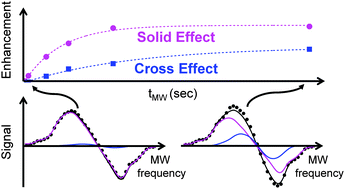Static 1H dynamic nuclear polarization with the biradical TOTAPOL: a transition between the solid effect and the cross effect†
Abstract
To study the solid state 1H-DNP mechanism of the biradical TOTAPOL under static conditions the frequency swept DNP enhancement spectra of samples containing 20 mM and 5 mM TOTAPOL were measured as a function of MW irradiation time and temperature. We observed that under static DNP conditions the biradical TOTAPOL behaves similar to the monoradical TEMPOL, in contrast to MAS DNP where TOTAPOL is considerably more effective. As previously done for TEMPOL, the TOTAPOL DNP spectra were analyzed taking a superposition of a basic SE-DNP lineshape and a basic CE-DNP lineshape with different amplitudes. The analysis of the steady state DNP spectra showed that the SE was dominant in the 6–10 K range and the CE was dominant above 10 K. DNP spectra obtained as a function of MW irradiation time allowed resolving the individual SE and CE buildup times. At low temperatures the SE buildup time was faster than the CE buildup time and at all temperatures the CE buildup time was close to the nuclear spin–lattice relaxation time, T1n. Polarization calculations involving nuclear spin-diffusion for a model system of one electron and many nuclei suggested that the shortening of the T1n for increasing temperatures is the reason why the SE contribution to the overall enhancement was reduced.


 Please wait while we load your content...
Please wait while we load your content...